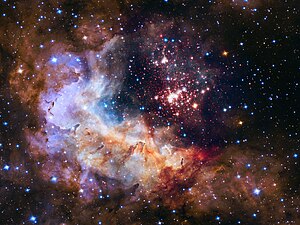Westerlund 2

Westerlund 2 is an obscured compact young star cluster (perhaps even a super star cluster[1]) in the Milky Way, with an estimated age of about one or two million years. It contains some of the hottest, brightest, and most massive stars known. The cluster resides inside a stellar breeding ground known as Gum 29, located 20,000 light-years away in the constellation Carina. It is half a degree from the naked eye Cepheid variable V399 Carinae.[2]
Cluster members
The cluster contains at least a dozen early O stars, of which at least three are eclipsing binaries. All are hotter than 38,000 K and more luminous than 230,000 L☉.[3] There are around 20 further O class stars in the cluster, all main sequence objects implying a very young age for the cluster.[4]
Several Wolf–Rayet stars are found in the vicinity of Westerlund 2, although not in the central core. WR20a, a binary consisting of two WR stars, and the single stars WR20aa, WR20b, and WR20c are all thought to be members of the cluster, although possibly now runaway members. All five Wolf Rayets are extremely young massive objects with OIf*/WN spectral types, amongst the most luminous stars in the galaxy. This composite spectral type indicates young very massive hydrogen-burning stars that are just starting to convect nitrogen and helium to the surface and develop denser stellar winds so that they show the emission lines of a Wolf-Rayet star. WR21a, itself a massive binary, lies in the same direction but is unlikely to be a member of Westerlund 2.[5]
Westerlund 2 also contains a large number of pre-main sequence stars with masses below 2.5 M☉. These stars constrain the age of the cluster to near 2 Myr.[6]
Discovery

As its name indicates, the Westerlund 2 cluster was discovered by Bengt Westerlund in the 1960s[7] but its stellar content was assessed only in later years.[8]
Hubble 25th Anniversary Image
On 23 April 2015 an image of the Westerlund 2 cluster was chosen to celebrate the 25th anniversary of the Hubble Space Telescope.[2]
See also
References
- ^ Y. Fukui; et al. (2015). "Cloud-cloud collision which triggered formation of the super star cluster RCW38". 1504: arXiv:1504.05391. arXiv:1504.05391. Bibcode:2015arXiv150405391F.
{{cite journal}}: Cite journal requires|journal=(help) - ^ a b "Hubble Space Telescope Celebrates 25 Years of Unveiling the Universe". NASA. 23 April 2015.
- ^ Rauw; et al. (1 March 2007). "Early-type stars in the core of the young open cluster Westerlund 2". Astronomy & Astrophysics. 463 (3): 981–991. arXiv:astro-ph/0612622. Bibcode:2007A&A...463..981R. doi:10.1051/0004-6361:20066495.
- ^ Hur, Hyeonoh; Park, Byeong-Gon; Sung, Hwankyung; Bessell, Michael S.; Lim, Beomdu; Chun, Moo-Young; Sohn, Sangmo Tony (2015). "Reddening, distance, and stellar content of the young open cluster Westerlund 2". Monthly Notices of the Royal Astronomical Society. 446 (4): 3797. arXiv:1411.0879. Bibcode:2015MNRAS.446.3797H. doi:10.1093/mnras/stu2329.
{{cite journal}}: CS1 maint: unflagged free DOI (link) - ^ Carraro, G.; Turner, D.; Majaess, D.; Baume, G. (2013). "The distance to the young open cluster Westerlund 2". Astronomy. 555: A50. arXiv:1305.4309. Bibcode:2013A&A...555A..50C. doi:10.1051/0004-6361/201321421.
- ^ Ascenso, J.; Alves, J.; Beletsky, Y.; Lago, M. T. V. T. (2007). "Near-IR imaging of Galactic massive clusters: Westerlund 2". Astronomy and Astrophysics. 466: 137–149. Bibcode:2007A&A...466..137A. doi:10.1051/0004-6361:20066433.
- ^ Bengt Westerlund (1 March 1961). "A Heavily Reddened Cluster in Ara". Astronomical Journal. 70: 57. Bibcode:1961AJ.....66T..57W. doi:10.1086/108585.
- ^ Moffat; et al. (1 August 1961). "New Wolf-Rayet stars in Galactic open clusters - Sher 1 and the giant H II region core Westerlund 2". Astronomical Journal. 102: 642–653. Bibcode:1991AJ....102..642M. doi:10.1086/115897.
External links
- Simbad
- Chandra Image of Westerlund 2
- Astronomy Picture of the Day - Young Star Cluster Westerlund 2 26 June 2010
